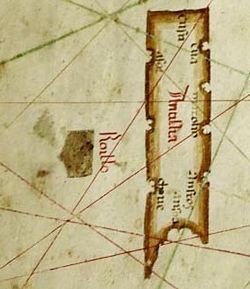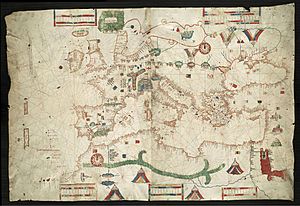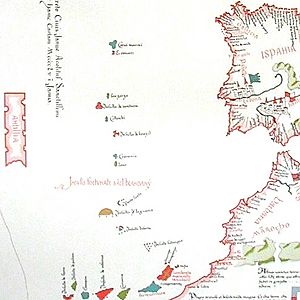Antillia facts for kids
Quick facts for kids Antillia |
|
|---|---|

Map of Albino de Canepa, dated 1489. Phantom island of Antillia, with its Seven Cities, on top; the smaller companion island of Roillo is below it.
|
|
| Portolan chart location | |
| Type | Phantom island |
Antillia (also called Antilia) is a phantom island. This means it was a legendary island that people believed existed, but it was never truly found. During the 1400s, when explorers were sailing across the Atlantic Ocean, many thought Antillia was far west of Portugal and Spain. It was also known as the Isle of Seven Cities.
The story of Antillia comes from an old legend in Spain and Portugal. Around the year 714, during the Muslim conquest of Hispania, seven Christian bishops wanted to escape the Muslim invaders. They sailed west into the Atlantic Ocean with their followers. They eventually landed on an island called Antillia. There, they built seven towns.
Antillia first appeared clearly on a map in 1424 by Zuane Pizzigano. After that, it was often shown on maps throughout the 1400s. But after 1492, when the North Atlantic Ocean was explored more, maps became more accurate. Antillia slowly disappeared from them. However, its name lives on in the Antilles, a group of islands in the Caribbean Sea.
Because Antillia was shown as a large island on 15th-century maps, some people wonder if it was actually a very early idea of the Americas. This has led to many theories about whether people from Europe visited America before Christopher Columbus.
Contents
What is the Legend of Antillia?

Stories about islands in the Atlantic Ocean have been told for a very long time. Ancient Greek writers like Plato wrote about the lost city of Atlantis. Other writers mentioned real places like the Canary Islands.
During the Middle Ages, Christian stories about these islands became popular. For example, there were tales of Irish missionaries like Saint Brendan sailing to mysterious islands. Norse sailors also explored Greenland and Vinland (North America). These stories often mixed together.
The legend of Antillia comes from Christian Spain and Portugal. The story says that around 714 AD, seven Christian bishops from Visigothic Spain fled from the Arab invaders. They sailed west with their people. They found an island and decided to live there. To make sure they couldn't go back, they burned their ships. The bishops then built seven cities on the island. Some names for these cities were Aira, Antuab, and Con.
A globe made by Martin Behaim in 1492 describes this legend. It says that in 734 AD, the island of Antillia, also called the Isle of the Seven Cities, was settled by the Archbishop of Porto and six other bishops. They brought their families, animals, and belongings from Spain. The globe also mentions that a Spanish ship came very close to the island in 1414.
Another map from 1507/08 by Johannes Ruysch also tells the story. It says that the Portuguese once found Antillia, but now it cannot be found. The people there spoke Spanish. They were believed to have fled from Spain during an invasion. The map mentions one archbishop and six other bishops, each with their own city. This is why it's called the island of seven cities. The people lived a very Christian life and had many riches.
Later versions of the story say that a Portuguese ship in 1447 found the island. The people there spoke Portuguese and asked if the Moors still controlled Spain. There were also rumors that silver could be found in Antillia's sands. This legend later led to the Spanish legends of the Seven Cities of Gold in America. Explorers believed these cities were very rich.
What Does the Name Antillia Mean?
The name Antillia likely comes from the Portuguese words "Ante-Ilha." This means "Fore-Island," "Island of the Other," or "Opposite Island." It might mean the island was thought to be directly "opposite" Portugal. Its shape and size on maps were often like a mirror image of Portugal.
Some people think "Ante-Ilha" isn't the best explanation. They believe "ante" should mean "opposite another island," not a continent. So, other ideas for the name's meaning exist. One idea is that "Antillia" is a changed version of Plato's "Atlantis." Another thought is that it comes from an old Roman name, Getulia, for a place in North Africa.
A famous explorer, Alexander von Humboldt, suggested it comes from the Arabic word al-Tin or al-Tennyn, meaning "dragon." This could refer to old Arab legends about sea dragons at the edge of the ocean.
A more recent idea is that Antillia might mean "in front of Thule." Thule was a semi-mythical name for Iceland. If so, "the island before Thule" could be Ireland. Ireland had seven "cities" at that time. However, Ireland was already well-known on maps.
Another idea is that the name "Antyllia" or "Antullia" (as seen on some old maps) means "Anti-Thule." This would mean the island is "opposite" or "beyond" Thule (Iceland) when sailing southwest. This theory suggests it refers to America.
How Was Antillia Shown on Maps?
When Europeans rediscovered the Canary Islands in the 1300s, it made people more interested in Atlantic island myths. Since real islands were found in the Atlantic, mapmakers started putting mythical islands on their charts too.
Antillia first clearly appeared on a map in 1424 by Zuane Pizzigano. He drew it as a large, red, rectangular island. It had bays and seven settlements. It was shown about 250 leagues (about 750 miles) west of Portugal. North of Antillia, Pizzigano drew another large island called Satanazes. West of Antillia was a smaller island called Ymana (later known as Royllo). These four islands often appeared together on maps in the 1400s.
Antillia appeared on many maps, including those by Battista Beccario (1435), Andrea Bianco (1436), and Grazioso Benincasa (1463). On some maps, Antillia was shown without Satanazes.
After Christopher Columbus's voyages to the Americas in the 1490s, Antillia mostly disappeared from maps. This is because the Atlantic Ocean was being mapped more accurately. However, it did appear on Johannes Ruysch's map in 1507-08.
On these maps, Antillia was usually drawn about the same size as Portugal. It was often a perfect rectangle, running north to south. It had seven bays, with a city on each bay. Sometimes, the shape was more detailed, showing river mouths or capes.
Later, around the time Spain discovered South America, Antillia was drawn much smaller on maps. Some people even thought Antillia might be São Miguel Island, the largest of the Azores. There is a national park there called Sete Cidades National Park, which means "Seven Cities National Park."
Medieval Beliefs and the Age of Discovery
A Portuguese legend tells how Antillia was settled in the early 700s. This was when the Moors (Muslims) were conquering Spain and Portugal. The Archbishop of Porto, six other bishops, and their followers sailed to the island to escape. Each group founded a city. Once they were settled, they burned their ships. This showed they would not go back.
The story says that a young couple later escaped from Antillia and returned to Europe. They told everyone that the seven cities were a perfect place. It was a model of good farming, economy, and culture. Over time, Antillia became known as a utopian place, free from problems.
Because this legend was so old, both Portugal and Spain claimed the island. The 1492 globe by Martin Behaim tells the story of the Catholic escape. It says a Spanish ship saw the island in 1414. A Portuguese crew claimed to have landed on Antillia in the 1430s.
In another version, the bishops fled from Mérida, Spain around 1150 when Moors attacked.
The idea of a rich civilization halfway between Europe and Japan made many explorers want to find the Seven Cities. By the late 1400s, Portugal stopped officially funding these trips. But in 1492, Christopher Columbus set sail for Asia under the Spanish flag. He thought Antillia would be a perfect stop along the way. He supposedly had maps and descriptions from a Spanish sailor who had visited Antillia.
After John Cabot's first trip to Newfoundland in 1497, some people thought he had found Antillia. Letters from that time mention Cabot landing on and sailing along the "Island of Seven Cities."
How Antillia Influenced Later Names
Some people, like Peter Martyr d'Anghiera, suggested that islands in the West Indies were Antillia. They often thought it was Puerto Rico or Trinidad. Because of this, the Caribbean islands became known as the Antilles.
As Europeans explored more of the Americas, maps showed Antillia getting smaller. It was usually placed in the middle of the Atlantic. But the legend of the Seven Cities of Gold moved to mainland Central or North America. Different European countries then competed to find these rich cities in the New World.
See also
 In Spanish: Antillia para niños
In Spanish: Antillia para niños


